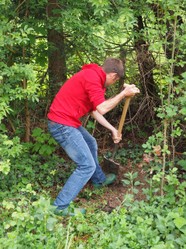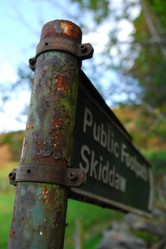I have just taken over an extra half plot of land to augment my existing allotment; and my eldest son Andrew and I are in the process of preparing it for cultivation next Spring [2017.] The reason behind this extra work is that I now have three homes to feed with fruit and vegetables. There is my own home, Andrew's young family and now Peter, son number two, is married and settled in Manchester. His wife is a vegetarian, so vegetables form a large part of their diet.So there is added demand on my gardening. I don't mind, for I have the time to garden, especially as I am winding up my tuition business and will have ended it by June. So more time for the allotment!
The plot was held by a young couple who had a young family, which they home educate. Lovely people, but they could not keep up the demands of a plot while rearing a family and the husband is working difficult hours. They have done a pretty good job of being rid of perennial weeds, but the ground surface show signs that it has been allowed to become overgrown with tussocky grass. So Andrew and I have begun the clearing process. Andrew took off much of the surface vegetation while I trimmed the bushes in the flower bed. Then we both set about digging, turning over the clods and extracting couch grass roots. This is troublesome weed species that must be rooted out. I am glad of the help of a younger man, and we are going to get help from my two daughters-in-law in Spring, but they have already decided that they want to help with herbs and flowers.
So without some digging no gardening can take place. Vegetables like a good, fine tilth, a soil turned into a fine crumb structure, and there they thrive. Furthermore, if you grow root crops such as potatoes you need to dig them out, and the same goes for carrots and parsnips. Furthermore, hoeing has a seriously important place in creating tilth, but hoeing disturbs only the surface and does not go as deep as digging does. In fact some digging can go down to two spades or more in depth,Sometimes you need to do this to eliminate pernicious weeds, such as Japanese knotweed.
Trees and rhubarb, both involve occasional digging. Every five years or so you need to lift and divide your rhubarb crowns to ensure continued vigour. So you must dig them up and break them into two or more pieces. If you plant trees you need to dig a hole for them to go into. So gardeners cannot avoid digging sometimes.










 TheThousand Year Garden28 days ago
TheThousand Year Garden28 days ago
 Women of the Gospelson 10/11/2025
Women of the Gospelson 10/11/2025
 Religious Gardenson 08/25/2025
Religious Gardenson 08/25/2025
 Doctor of the Church: John Henry Newmanon 08/03/2025
Doctor of the Church: John Henry Newmanon 08/03/2025




Comments
Snakes, such as aďers do get under matting, butb snakes are scarce in Britain
Thank you for your comment below in answer to my previous observation and question.
Sometimes I mow the tall grass so that it moves downward into natural grassy pathways. That grass nestles nicely above the bare ground even as snakes sometimes nestle there too. So I instead observe bare-ground pathways by removing the long grass.
Might snakes occur around, atop, under weed matting in the eastern-pond lands?
Yes,weed matting is an important element in the no dig method.
Thank you for your comment below in answer to my previous observation and question.
Your answer, to another observation and question, three comment boxes down, on Mar 3, 2017, discusses weed matting. Is that a mat made of weeds to place over weeds or a mat made of something else to put over weeds?
A garden claw is useful for tussocks,but a good spade or fork will be useful.
frankbeswick, Thank you for product lines, pretty pictures and practical information.
The north and south lawns are hosts to non-turf bunch-grass borders. They attract such birds as indigo buntings and such butterflies as black and tiger swallowtails. So I "landscape" them as arching clumps between bunch-grass, manual-mowered pathways.
So I leave what's there there, and if I must remove, I resort to what I call hand-mowing (= kneeled down pulling them out blade by blade for the more recalcitrant, bunch by bunch for the less).
Your subheading "Digging in the Garden" mentions that "the ground surface show signs that it has been allowed to become overgrown with tussocky grass. So Andrew and I have begun the clearing process. Andrew took off much of the surface vegetation while I trimmed the bushes in the flower bed. Then we both set about digging, turning over the clods and extracting couch grass roots."
How and with what was the surface vegetation cleared, and what equipment was used for digging out weed-grass roots?
That sounds like a well-tilled garden! I too have used weed matting. I have covered all the paths with it, and on the beds that I am using for salads I am going to plant seedlings through slits in the matting. The matting worked for my paths, which in the last rain-soaked year that we had in Britain were invaded by couch grass and caused me much trouble. The bad weather caused my herb beds to be weed-infested, so what I did was to lay a large fabric mat across the bed and place my planters on top of it. Thus the weeds cannot force their way up through the herbs, as they did last year, meaning that I could not destroy the weeds without killing the herbs.
Thanks for the tweet. I am not on Twitter, so I cannot tweet.
Good food for thought. I have the same garden plot I have used for the past twenty years. I have it as close to organic as possible. I till it every spring although lost year I put down weed matting between rows and it work wonderfully because I lightly refilled the rows to loosen up the soil, it worked the matting stuck well I wet it with the garden hose to help out. anyway the weed matting is still firm in place and free of anything growing so I think I am going to leave it and till around it after all if it ain't broke... gonna tweet and share this fine gardening spot
To confirm my view that some digging, at least initially, is necessary. The new half plot that I have taken over has not been properly dug for several years, not since a very industrious Irishman left us. Since then it has been in inadequate hands, and the ground is simply not fit for planting.I have been working hard to clear the grassy surface and dig the ground over. With the wet weather that we are having at present [December] the ground is very hard to dig and heavy to work.
We will get it right, but I have also found that it is low on humus, the black material that makes for good soil,so I am going to have to apply compost and manure, lots of it. Working undug soil in December was very arduous.
I must confess that when I started reading I was expecting hydroponics, or some other such practice. Nicely done. And I learned there are other ways to not dig than use water.